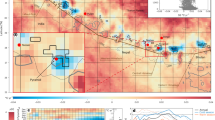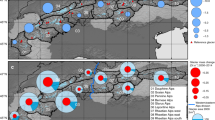Abstract
During the past 150 years, mountain glaciers have shown a worldwide retreat. It has been argued that this is related to the warming which is predicted to result from increased carbon dioxide levels in the atmosphere; however, this warming has not been detected in a statistically significant way from instrumental records. I demonstrate here that the lower part of a valley glacier is extremely sensitive to a local warming, induced by an increase in the radiation budget. For glaciers covering only a small fraction of a valley, the effect is particularly dramatic. Thus valley glaciers may be extremely vulnerable to the presence of infrared-absorbing gases in the atmosphere, and could therefore be better detectors of a possible carbon dioxide warming than is generally assumed.
This is a preview of subscription content, access via your institution
Access options
Subscribe to this journal
Receive 51 print issues and online access
$199.00 per year
only $3.90 per issue
Buy this article
- Purchase on Springer Link
- Instant access to full article PDF
Prices may be subject to local taxes which are calculated during checkout
Similar content being viewed by others
References
Messerli, B., Messerli, P., Pfister, C. & Zumbühl, H. J. Arct. alp. Res. 10, 247–260 (1978).
Vivian, R. Les Glaciers des Alpes Occidentals (Allier, Grenoble, 1975).
Messerli, B. et al. Z. Gletscherk. Glazialgeol. 9, 3–110 (1975).
International Association of Scientific Hydrology Fluctuations of Glaciers Vols 1–3 (UNESCO, Paris, 1967, 1973, 1977).
Ostrem, G., Liestol, O. & Wold, B. Norsk geogr. Tidsskr. 30, 187–209 (1977).
Meier, M. F. Scieence 226, 1418–1421 (1984).
Martin, S. Z. Gletscherk. Glazialgeol. 13, 127–153 (1977).
Young, G. J. Z. Gletscherk. Glazialgeol. 13, 111–125 (1977).
Reynand, L. in Varuations in the Global Water Budget, (eds?) 197–205 (Reidel, Dordrecht, 1983).
Kuhn, M. in Sea Level, Ice and Climatic Change (ed. Allison, I.) 3–20 (International Association of Scientific Hydrology, Paris, 1979).
Louis, J. F., European Centre for Medium Range Weather Forecasts intern. Rep. no. 4 (Reading, 1977).
Ramanathan, V. J. atmos. Sci. 38, 918–930 (1981).
Sellers, W. D. Physical Climatology (University of Chicago Press, 1965).
Kukla, G. in Sea Level, Ice and Climatic Change (ed. Allison, I.) International Association of Scientific Hydrology, 79–108 (UNESCO, Paris, 1979).
Author information
Authors and Affiliations
Rights and permissions
About this article
Cite this article
Oerlemans, J. Glaciers as indicators of a carbon dioxide warming. Nature 320, 607–609 (1986). https://doi.org/10.1038/320607a0
Received:
Accepted:
Published:
Issue Date:
DOI: https://doi.org/10.1038/320607a0
This article is cited by
-
Major ion chemistry and atmospheric CO2 consumption deduced from the Batal glacier, Lahaul–Spiti valley, Western Himalaya, India
Environment, Development and Sustainability (2020)
-
The distribution of ciliates on Ecology Glacier (King George Island, Antarctica): relationships between species assemblages and environmental parameters
Polar Biology (2013)
-
Changes in physical features of Glacier No. 1 of the Tianshan Mountains in response to climate change
Chinese Science Bulletin (2011)
-
An annotated bibliography on the greenhouse effect and climate change
Climatic Change (1992)
-
The significance of global snow and ice cover for global change studies
GeoJournal (1992)
Comments
By submitting a comment you agree to abide by our Terms and Community Guidelines. If you find something abusive or that does not comply with our terms or guidelines please flag it as inappropriate.



